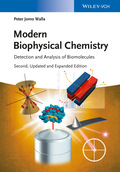Modern Biophysical Chemistry
Detection and Analysis of Biomolecules

2. Edition August 2014
360 Pages, Softcover
240 Pictures (40 Colored Figures)
10 tables
Textbook
Short Description
A brief introduction for readers with a background in biochemistry or biophysics to current technology for the analysis of proteins and other biomolecules, now in an updated and expanded edition that includes super-resolution microscopy and other novel methods.
Buy now
Price: 71,90 €
Price incl. VAT, excl. Shipping
Euro prices for Wiley-VCH and Ernst & Sohn titles are only valid for Germany. In EU countries, local VAT applies. Postage will be charged.
This updated and up-to-date version of the first edition continues with the really interesting stuff to spice up a standard biophysics and biophysical chemistry course. All relevant methods used in current cutting edge research including such recent developments as super-resolution microscopy and next-generation DNA sequencing techniques, as well as industrial applications, are explained. The text has been developed from a graduate course taught by the author for several years, and by presenting a mix of basic theory and real-life examples, he closes the gap between theory and experiment.
The first part, on basic biophysical chemistry, surveys fundamental and spectroscopic techniques as well as biomolecular properties that represent the modern standard and are also the basis for the more sophisticated technologies discussed later in the book. The second part covers the latest bioanalytical techniques such as the mentioned super-resolution and next generation sequencing methods, confocal fluorescence microscopy, light sheet microscopy, two-photon microscopy and ultrafast spectroscopy, single molecule optical, electrical and force measurements, fluorescence correlation spectroscopy, optical tweezers, quantum dots and DNA origami techniques. Both the text and illustrations have been prepared in a clear and accessible style, with extended and updated exercises (and their solutions) accompanying each chapter.
Readers with a basic understanding of biochemistry and/or biophysics will quickly gain an overview of cutting edge technology for the biophysical analysis of proteins, nucleic acids and other biomolecules and their interactions. Equally, any student contemplating a career in the chemical, pharmaceutical or bio-industry will greatly benefit from the technological knowledge presented. Questions of differing complexity testing the reader's understanding can be found at the end of each chapter with clearly described solutions available on the Wiley-VCH textbook homepage under: www.wiley-vch.de/textbooks
PART I: Basic Methods in Biophysical Chemistry
BASIC OPTICAL PRINCIPLES
Introduction
What Does the Electronic Structure of Molecules Look Like? Orbitals, Wave Functions and Bonding Interactions
How Does Light Interact with Molecules? Transition Densities and the Transition Dipole Moment
Absorption Spectra of Molecules in Liquid Environments. Vibrational Excitation and the Franck-Condon Principle
What Happens After Molecules have Absorbed Light? Fluorescence, Nonradiative Transitions and the Triplet State
Quantitative Description of all Processes: Quantum Efficiencies, Kinetics of Excited State Populations and the Jablonski Diagram Problems
OPTICAL PROPERTIES OF BIOMOLECULES
Introduction
Experimental Determination of Absorption and Fluorescence Spectra
Optical Properties of Proteins and DNA
Optical Properties of Important Cofactors
BASIC FLUORESCENCE TECHNQUES
Introduction
Fluorescent Labelling and Linking Techniques
Fluorescence Detection Techniques
Fluorscence Polarization Anisotropy
Förster Resonance Energy Transfer
Fluorescence Kinetics
Fluorescence Recovery after Photobleaching
Biochemiluminescence
CHIROPTICAL AND SCATTERING METHODS
Chiroptical Methods
Light Scattering
Vibrational Spectra of Biomolecules
MAGNETIC RESONANCE TECHNIQUES
Nuclear Magnetic Resonance of Biomolecules
Electron Paramagnetic Resonance
MASS SPECTROMETRY
Introduction
MALDI-TOF
ESI-MS
Structural and Sequence Analysis Using Mass Spectrometry
PART II: Advanced Methods in Biophysical Chemistry
FLUORESCENCE MICROSCOPY
Introduction
Conventional Fluorescence Microscopy
Total Internal Reflection Fluorescence Microscopy
Light-Sheet Microscopy
SUPER-RESOLUTION FLUORESCENCE MICROSCOPY
Stimulated Emission Depletion (STED) Microscopy
Photoactivated Localization Microscopy (PALM) and Stochastic Optical Reconstruction Microscopy (STORM)
3D Super-Resolution Fluorescence Microscopy
Imaging of Live Cells
Multicolour Super-Resolution Fluorescence Microscopy
Structured Illumination Microscopy
SOFI
Final Comparison
SINGLE-BIOMOLECULE TECHNIQUES
Introduction
Optical Single-Molecule Detection
Fluorescence Correlation Spectroscopy
Optical Tweezers
Atomic Force Microscopy of Biomolecules
Patch Clamping
ULTRAFAST- AND NONLINEAR SPECTROSCOPY
Introduction
Nonlinear Microscopy and Spectroscopy
Ultrafast Spectroscopy
DNA SEQUENCING AND NEXT-GENERATION SEQUENCING METHODS
Sanger Method
Next-Generation Sequencing Methods
SPECIAL TECHNIQUES
Introduction
Fluorescing Nanoparticles
Surface Plasmon Resonance Detection
DNA Origami
DNA Microarrays
Flow Cytometry
Fluorescence In Situ Hybridization
Microspheres and Nanospheres
ASSAY DEVELOPMENT, READERS AND HIGH-THROUGHPUT SCREENING
Introduction
Assay Development and Assay Quality
Microtitre Plates and Fluorescence Readers
Application Example: Drug Discovery and High-Throughput Screening
Index


